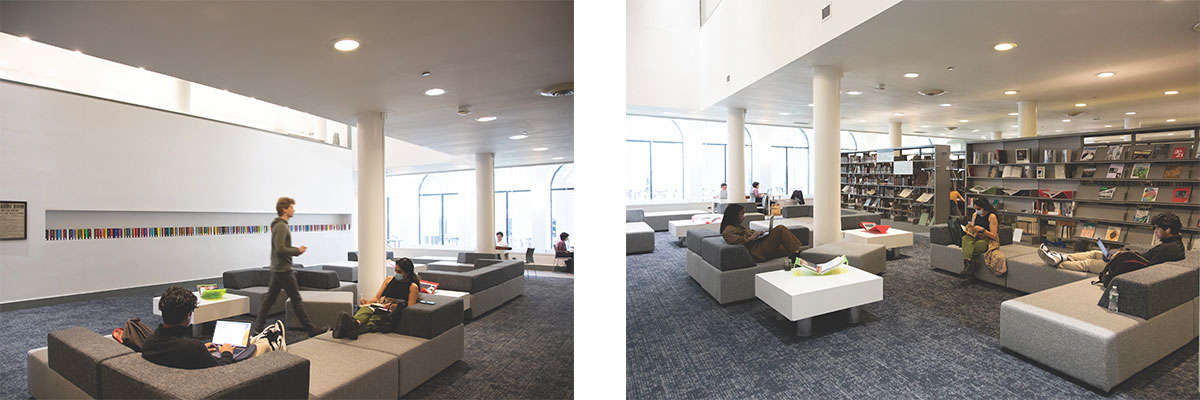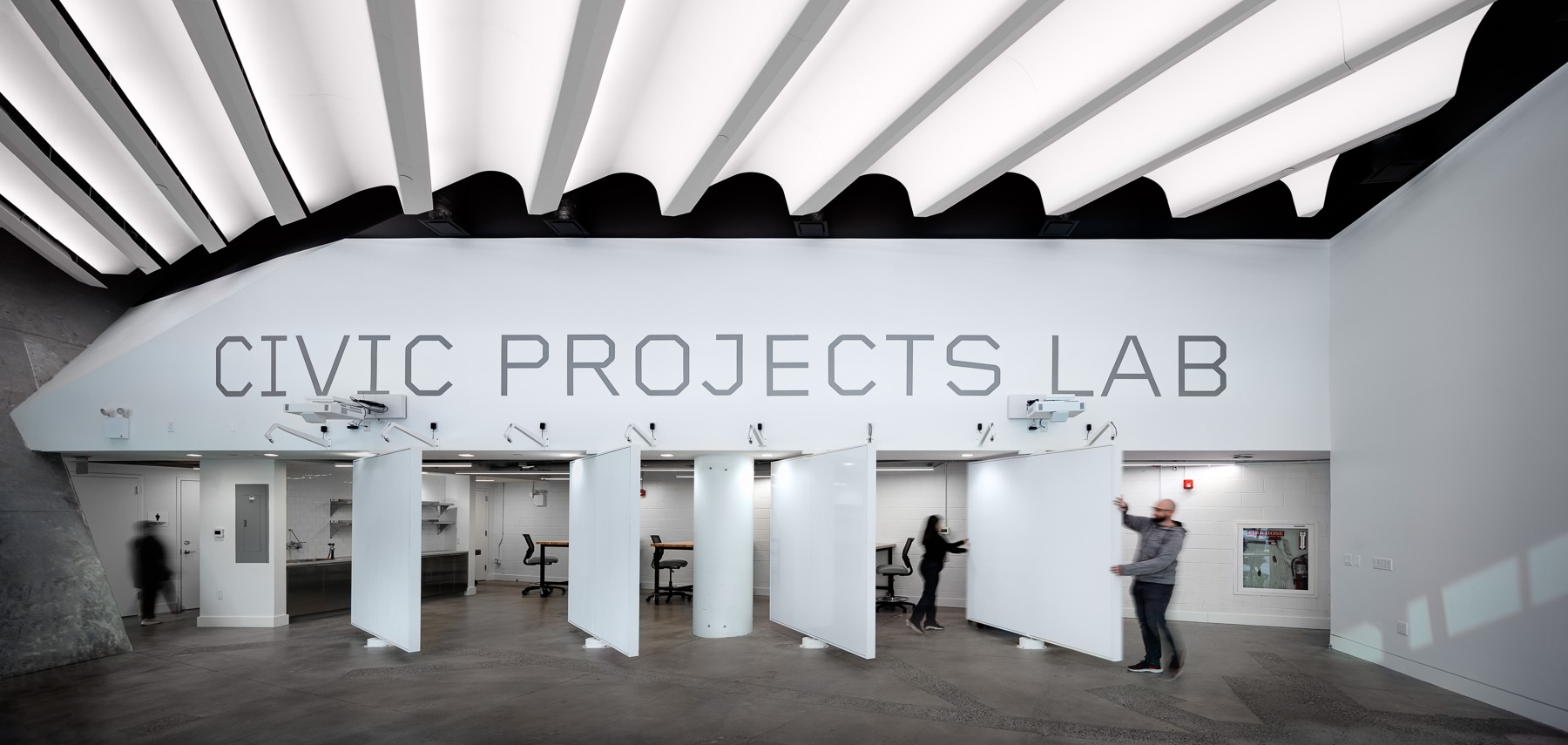Space for Renewal
POSTED ON: August 3, 2023

Photo: Marget Long
This spring, passersby on Cooper Square were treated to the first glimpse of the Foundation Building’s refurbished façade, free from the sidewalk bridge and scaffolding that cloaked the storied landmark for over a year. The work marks one of the most significant preservation efforts undertaken at Cooper since the 1970s, when John Hejduk AR’50 set his iconic redesign within the building’s 19th-century shell. Inside, beyond the lobby, there is new vitality as well: The Cooper Union Library is abuzz, with an updated atrium hosting club meetings and faculty talks, tables encircled by students collaborating on projects, and a fully reimagined Center for Writing and Learning.
The Foundation Building face-lift and ongoing library renovations have followed recent initiatives to invest in the college’s physical spaces. In 2018, when The Cooper Union’s Board of Trustees approved the Plan to Return to Full Tuition Scholarships, they identified the need for accruing reserves for deferred maintenance and capital improvements as integral to stewarding financial health. With help from grants and donors, Cooper has since increased those investments.
“As we work to raise scholarship levels, we didn’t want to just stop making other improvements for students and faculty,” says Natalie Brooks, Cooper’s chief talent officer, who oversees facilities projects. In 2019, she and President Sparks sat down with the deans of each school to develop a master plan for allocating the capital expenditures budget, identifying priorities for utilizing limited campus space and resources. “It’s always safety and student needs that come first,” Brooks says.
Concerns over safety lent some urgency to restoring the Foundation Building, which was at the time of its construction in 1859 one of the tallest in Manhattan. A comprehensive study of the exterior undertaken two years ago—the first in more than 20 years—revealed the need for immediate masonry repairs. And because of the building’s designation as a New York City landmark, everything from replacing brownstone and terra-cotta to matching paint colors required approval by the Landmarks Preservation Commission. Consultants and architects at SOCOTEC and PRESERV Building Restoration—firms that incidentally both employ Cooper alumni—have led the restoration project, now nearing completion.
“We wanted to make sure that the façade work would be finished in time for Commencement,” Brook says. With the scaffolding and most of the sidewalk bridges removed from the sides of the building, repairs to the roof are underway.
In all, revitalizing the Foundation Building has cost $5.4 million, aided by a matching grant of $750,000 awarded through New York State’s Environmental Protection Fund Program for Parks, Preservation, and Heritage. The college has plans to conduct a study of the building every five years, helping mitigate maintenance costs and ensure the long-term preservation of an important piece of New York architectural history. In addition to repairs to the roof, an extensive renovation of the backstage green room of the Great Hall is taking place this summer, improving accessibility in the 164-year-old venue. Simultaneously, the college plans to repair the Student Residence Hall façade and find a new renter for the attached retail spaces, which are currently under renovation.

Further revitalization of the Cooper Library is also in the works. The first phase began last summer, led by architecture firm Method Design, and included updating the spaces used by The Cooper Union Archives and Special Collection and reorganizing the main bookstacks to expand study areas, add furniture, and repurpose the atrium as a public forum. The aim for this summer is to continue enhancing the library space and its resources based on feedback from the community, by installing whiteboards, more electrical outlets, accessible bathrooms, and quiet spaces. Even relatively minor upgrades have so far proven quite popular.
“The response from students and faculty has been overwhelmingly positive,” says Lisa Norberg, director of the library. “Our gate count—the number of people coming into the library—has gone from an average of 1,200 per week to over 5,000 per week.”
Before they could free up floor space, Norberg and her team embarked on a two-year analysis of the library collections, soliciting input from faculty members to cull damaged, redundant, and outdated materials. The approach, which she describes as “just in time rather than just in case,” is meant to reflect the evolving role of the library.
“The changes led by Lisa and the library staff have totally activated the library in new ways,” says Brooks. “The last renovation, in the 1970s, was done at a time when libraries were judged solely by how many books they had on the shelves. Today, libraries are also places for sharing and collaboration.”
Moving the Center for Writing from 41 Cooper Square to a new home within the library—a longtime goal for the college—was similarly motivated by a desire for collaborative learning. With support from the Gelb Family Foundation, the renamed Center for Writing and Learning is now, according to its director Kit Nicholls, not only closer to the library’s research materials, but also better positioned to engage Cooper students, faculty, and staff from all schools in creative, interdisciplinary projects and pedagogies [see “A New Center for Writing and Learning in the Library”].
“We are absolutely thrilled to have the Center in our space and are delighted with the collaborations and initiatives it has already generated,” says Norberg. “We look forward to continuing to transform the library into a space that supports the teaching, learning, scholarly, and creative endeavors of the Cooper community.”
Brooks notes that the Center’s relocation afforded the opportunity to add much-needed classroom capacity to 41 Cooper Square following the introduction of block scheduling and more electives across the curriculum. “We’re a small campus, so we try to be creative in meeting everyone’s wants and needs,” she says.
Brooks has worked with each of the schools and various departments to ensure capital expenditures fulfill their wishlists while being mindful of the college’s tight urban quarters. Remodeling the dean’s office in the School of Engineering to include a state-of-the-art conference room, for instance, freed up academic space previously overbooked for administrative meetings. Other expenditures have included a renovation of the School of Art’s photography lab and new workspaces in the large architecture studio.
Thanks to external funding, the recent improvements have even included all-new facilities that support the goal of fostering interdisciplinary work. In 2018, the college was awarded $2 million by the IDC Foundation to transform the fourth-floor lobby of the Foundation Building into a high-tech maker space, the IDC Foundation Art, Architecture, Construction, and Engineering (AACE) Lab. New York State also supported the project through the Higher Education Capital Matching Grant Program. Since then, the facility’s technologies have been incorporated into student projects across all three schools, including cross-disciplinary collaborations that range from an interactive sculpture created by electrical engineering and art students to a 3D software tutoring program led by students in the School of Architecture. According to Harrison Tyler, director of the AACE Lab, nearly 500 different Cooper students actively made use of the lab this year, with proportional representation from each school.

Last year, after space in 41 Cooper Square formerly rented by a private preschool became available, Cooper unveiled the Benjamin Menschel Civic Projects Lab, along with a new student information and admissions center called the Hub. Funded by the generosity of the Menschel family—longtime supporters of interdisciplinary work at Cooper—the Civic Projects Lab is an all-in-one classroom, workspace, and public showcase designed to facilitate engagement with the surrounding New York City community. The lab has been used for projects that partner with local nonprofits as part of the popular Data Science and Design Projects for Social Good course, taught by Sam Keene, professor of electrical engineering.
Smaller facilities investments—adding more lounge furniture and replacing plastic water jug delivery with more sustainable bottle-filling stations—have made a noticeable difference in the quality of campus life, too. As Cooper moves toward closing the budget gap in its deferred maintenance, Brooks says the hope is to continue looking for ways to enrich the student experience. “It’s exciting to see all this new activity around campus and the interdisciplinary work that has resulted from just three years of facilities improvements,” she says. “And we’re still looking ahead to do even more.”




